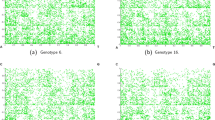Abstract
Human papillomavirus (HPV) is considered to be the most common sexually transmitted disease and the infection of HPV is known as the major factor for cervical cancer. There are more than 100 types in HPV and each HPV has two risk types, low and high. In particular, high risk type HPV is known to the most important factors in medical judgment. Thus, the classifying the risk type of HPV is very important to the treat of cervical cancer. In this paper, we present a machine learning approach to mine the structure of HPV DNA sequence for effective classification of the HPV risk types. We learn the most informative subsequence segment sets and its weights with genetic algorithm to classify the risk types of each HPV. To resolve the problem of computational complexity of genetic algorithm we use distributed intelligent data engineering platform based on active grid concept called “IDEA@Home.” The proposed genetic mining method, with the described platform, shows about 85.6% classification accuracy with relatively fast mining speed.
Access this chapter
Tax calculation will be finalised at checkout
Purchases are for personal use only
Preview
Unable to display preview. Download preview PDF.
Similar content being viewed by others
References
Bosch, F.X., Manos, M.M., Muñoz, N., Sherman, M., Jansen, A.M., Peto, J., Schiffman, M.H., Moreno, V., Kurman, R., Shah, K.V.: Prevalence of human papillomavirus in cervical cancer: A worldwide perspective. J. Natl. Cancer Inst. 87(11), 796–802 (1995)
Furumoto, H., Irahara, M.: Human Papillomavirus (HPV) and Cervical Cancer. Journal of Medical Investigation 49, 124–133 (2002)
Schiffman, M., Bauer, H., Hoover, R., Glass, A., Cadell, D., Rush, B., Scott, D., Sherman, M., Kurman, R., Wacholder, S.: Epidemiologic evidence showing that Human Papillomavirus infection causes most cervical intraepithelial neoplasis. Journal of the National Cancer Institute 85, 958–964 (1993)
Park, S.-B., Hwang, S.-H., Zhang, B.-T.: Classification of the risk types of human papillomavirus by decision trees. In: Proceedings of the 4th International Conference on Intelligent Data Engineering and Automated Learning, pp. 540–544 (2003)
Janicek, M.F., Averette, H.E.: Cervical cancer: Prevention, diagnosis, and therapeutics. Cancer Journals for Clinicians 51, 92–114 (2001)
Burk, R.D., Ho, G.Y., Beardsley, L., Lempa, M., Peters, M., Bierman, R.: Sexual behavior and partner characteristics are the predominant risk factors for genital human papillomavirus infection in young women. J. Infect. Dis. 174(4), 679–689 (1996)
Muñoz, N., Bosch, F.X., Sanjosé, S., Herrero, R., Castellsagué, X., Shah, K.V., Snijders, P.J.F., Meijer, C.J.L.M.: Epidemiologic classification of human papillomavirus types associated with cervical cancer. The New England Journal of Medicine 348(6), 518–527 (2003)
Eom, J.-H., Zhang, B.-T.: IDEA@home: The flexible active grid computing platform based on P2P and network segmentation. Technical Report BI-04-01, School of Computer Sci. & Eng., Seoul National Univ., Seoul, Korea (February 2004)
Richards, W.G.: Virtual screening using grid computing: the screensaver project. Nature Reviews Drug Discovery 1, 551–555 (2002)
Davies, E.K., Glick, M., Harrison, K.N., Richards, W.G.: Pattern recognition and massively distributed computing. Journal of Computational Chemistry 23(16), 1544–1550 (2002)
Bäck, T.: Evolutionary algorithms in theory and practice. Oxford University Press, Oxford (1996)
Kim, S., Zhang, B.-T.: Genetic mining of HTML structures for effective web-document retrieval. Applied Intelligence 18, 243–256 (2003)
The HPV sequence database in Los Alamos laboratory, http://hpv-web.lanl.gov/stdgen/virus/hpv/index.html
Author information
Authors and Affiliations
Editor information
Editors and Affiliations
Rights and permissions
Copyright information
© 2004 Springer-Verlag Berlin Heidelberg
About this paper
Cite this paper
Eom, JH., Park, SB., Zhang, BT. (2004). Genetic Mining of DNA Sequence Structures for Effective Classification of the Risk Types of Human Papillomavirus (HPV). In: Pal, N.R., Kasabov, N., Mudi, R.K., Pal, S., Parui, S.K. (eds) Neural Information Processing. ICONIP 2004. Lecture Notes in Computer Science, vol 3316. Springer, Berlin, Heidelberg. https://doi.org/10.1007/978-3-540-30499-9_208
Download citation
DOI: https://doi.org/10.1007/978-3-540-30499-9_208
Publisher Name: Springer, Berlin, Heidelberg
Print ISBN: 978-3-540-23931-4
Online ISBN: 978-3-540-30499-9
eBook Packages: Springer Book Archive




